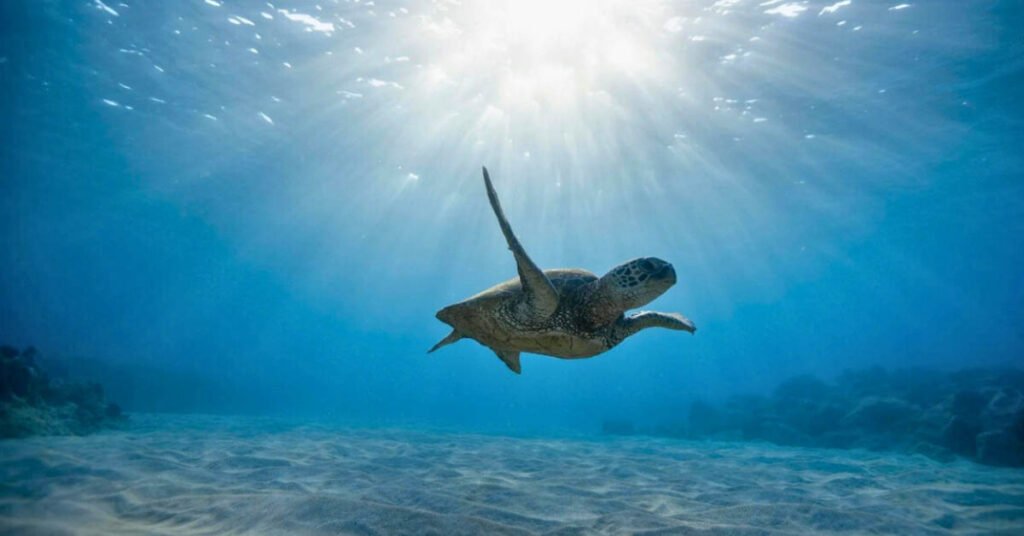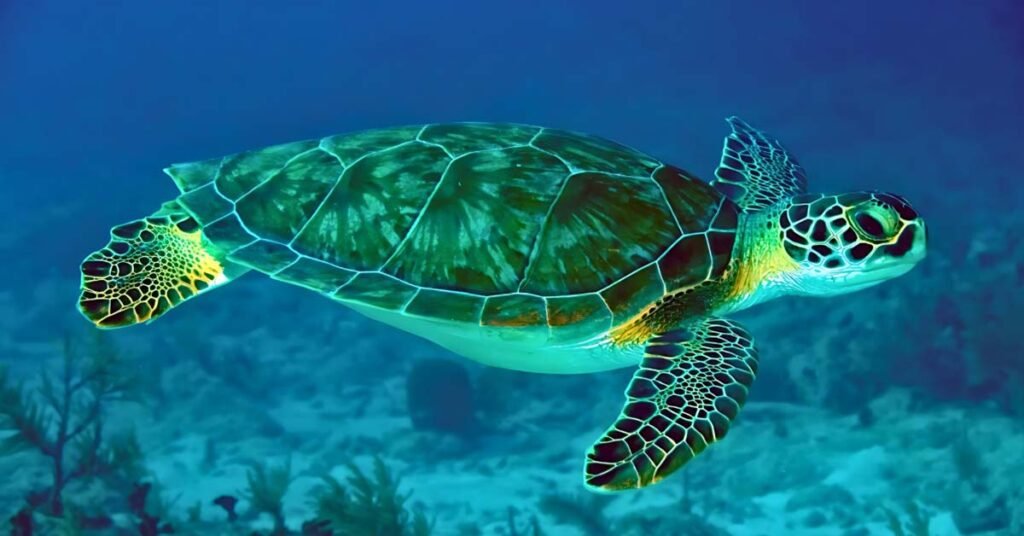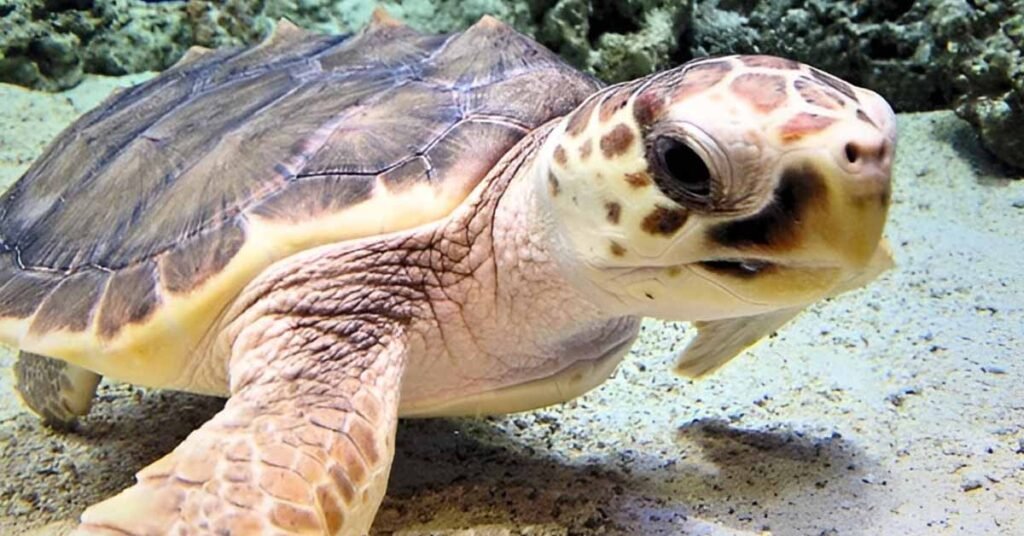Sea turtles have been around for such a long time, about 110 million years! It is super cool to watch these creatures glide gracefully through the oceans. But guess what? They’re not just aimlessly swimming around. So, do sea turtles migrate, or do they travel aimlessly? Some sea turtles go on these location-changing trips called migrations.
Imagine a sea turtle going on a big adventure, swimming thousands of miles across the ocean! It’s not just a fun journey; it’s essential for their survival and helps keep the ocean in balance. Let’s take a closer look at this exciting question: Do sea turtles migrate? If they do, why?
Do Sea Turtles Migrate?

Yes, many sea turtle species go on long migrations, traveling thousands of miles across the oceans. They migrate mainly for food, hatchling needs, breeding, and temperature regulation.
After baby sea turtles hatch, they start a long journey across the big ocean to find food. For instance – loggerhead turtles travel across the Atlantic Ocean a long way to reach their nesting spots near the Azores islands, which are close to Portugal.
They stay there for 7 to 14 years, getting bigger and stronger. Then, they travel again to live near the shores of the Atlantic Ocean, in places like the Gulf of Mexico.
Why Do Sea Turtles Migrate?

It might seem like sea turtles are just floating around, but they’re actually incredible travelers. There are a few reasons why they take on these long migration journeys:
For Food
Just like us, sea turtles need to eat. Some species migrate to areas overflowing with yummy food, following plankton or jellyfish feasts throughout the year. For example, green sea turtles are like underwater vegetarians. They love munching on seagrass, and their migrations often follow underwater food needs.
Hatchling Migration
Even the very young sea turtles, which have just been hatched from their eggs, take part in the migration process. Predators hunt on the beaches and in shallow waters, waiting for a chance to bite-sized hatchling sea turtles. To avoid danger, these little adventurers have a built-in instinct to scoot away from danger.
The first 24-36 hours of hatchling migration are known as the “frenzy period,” when baby turtles swim almost non-stop. These little adventurers swim across the ocean to find safe feeding grounds where they can grow big and strong.
According to researchers, newborn loggerhead turtles start their first migration to find food. These young turtles swim far to get plankton food, a nutritious soup in the ocean that helps them grow.
Family Reunions
Many sea turtles return to the same beaches where they hatched as tiny tots. This incredible homing instinct ensures their offspring have the best chance of survival on familiar beaches.
Green sea turtles are strongly connected to their nesting beaches. They travel long distances to return to these special spots for breeding.
Temperature Requirement
Sea turtles are cold-blooded, which means their body temperature depends on the environment. Migration allows them to travel to warmer or cooler waters as needed, keeping themselves comfy and healthy.
All sea turtles can be affected by temperature and may migrate to find more comfortable water. Kemp’s ridley sea turtles, for example, favor warmer waters and migrate seasonally to find optimal nesting and foraging grounds.
Note: Research suggests that during migration, their activity level increases, which means they need more oxygen. This is reflected in their VO2 (amount of oxygen used). Interestingly, more giant turtles have a higher capacity for this increased activity. Scientists believe these migrations help sea turtles regulate their internal temperature, allowing them to keep going.
Migration Patterns of Different Species of Sea Turtles

Researchers found that some sea turtles have shown specific needs for migration. Here are some of those:
Green Sea Turtles
Green sea turtles are known for their loyalty to nesting beaches, as we gave an example above. They travel long distances to reach these precise locations for breeding.
Loggerhead Sea Turtles
The loggerhead sea turtle migrates through a series of foraging spots, unlike the green sea turtle. This means they don’t stick to just one feeding area. Instead, they move between multiple locations during their migration journeys. In these foraging sites, they can get the food sources they need to sustain their long journeys.
Leatherback and Olive Ridley Sea Turtles
These turtle species, like leatherback and olive ridley turtles, stick to something other than particular coastal spots for food. Instead, they go out to sea, where their movements are pretty intricate and without a clear direction.
Ecology and Behavior of Sea Turtles’ Migration
We have already discussed the main reasons behind the need for sea turtle migration. Now, let’s see their overall ecological and behavioral migration reasoning:
Habitat Preferences
Sea turtles have their favorite hangouts depending on what they like to munch on. Leatherback turtles love the deep, open ocean, especially where jellyfish are abundant – they’re like the burger joints for these turtles! Meanwhile, green sea turtles prefer coastal spots with lots of seagrass and algae, their go-to salad bars.
Migration Routes
Sea turtles are like seasoned travelers, taking long journeys made to their needs. Each species has its roadmap, traveling far and wide with the changing seasons. They’re smart about using ocean currents like underwater highways to guide their way through different sea zones.
Nesting Behaviors
Nesting time is a big deal for sea turtles. They’re picky about when and where they lay their eggs, timing it just right for optimal hatching conditions. Sandy beaches away from the high tide are their top picks. Some turtles prefer solo nests, while others go to massive egg-laying parties called arribadas, where it’s a turtle fiesta on the shore.
How Sea Turtles Navigate Long Journeys
Sea turtles can migrate long distances up to 10,000 miles or more than this per year. But how do these long-distance travelers find their way across vast stretches of ocean? Here’s where the mystery deepens:
The Earth’s Magnetic Field
Imagine having a built-in GPS that uses the Earth itself as a map! Some scientists believe sea turtles use the Earth’s magnetic field to navigate. The Earth has a natural magnetic field, like an invisible force field surrounding the planet.
Research suggests sea turtles may sense variations in this magnetic field, determining direction and location. It’s like having a built-in map based on the Earth’s natural magnetism.
The Sun and Stars
Have you ever heard of navigating by the stars? Well, some experts believe sea turtles might be like celestial sailors, using the sun and stars to stay on course. They can recognize specific constellations or the sun’s position throughout the day to maintain their direction. This ability, combined with their magnetic sense, could be their secret to navigating the vast, open ocean.
FAQs
Why do sea turtles migrate?
Sea turtles migrate for two main reasons: food hunting and mating. Other than these reasons, sea turtles also migrate to avoid danger during the hatchling period and to avoid temperature requirements as they are cold-blooded.
Do green sea turtles migrate?
Yes, green sea turtles are known for their impressive migrations. They travel hundreds to thousands of kilometers to get from feeding grounds to nesting beaches. Green sea turtles are one of the many sea turtle species that undertake long journeys.
Do hawksbill sea turtles migrate?
Like many other sea turtle species, hawksbills migrate. They travel long distances between the areas where they find food (hunting grounds) and the beaches where they lay their eggs (nesting beaches). An adult female hawksbill nesting in the U.S. Virgin Islands was tracked, traveling over 1,160 miles to reach its feeding grounds in Nicaragua!
Do leatherback sea turtles migrate?
Leatherback sea turtles are the ultimate travelers of the reptile world! These incredible creatures hold the record for the farthest migration of any reptile on Earth. They travel mind-blowing distances – sometimes over 10,000 miles a year.
Read More: Can Turtles Get Rabies?
Wrap Up
Do sea turtles migrate? The straightforward answer is yes. Most sea turtle species, such as green sea turtles, loggerheads, Leatherbacks, Olive ridleys, and Hawkbills, are known for their migration habits.
As we discussed above, they do not migrate for fun; it is a necessary cycle for their ecological or behavioral needs.
